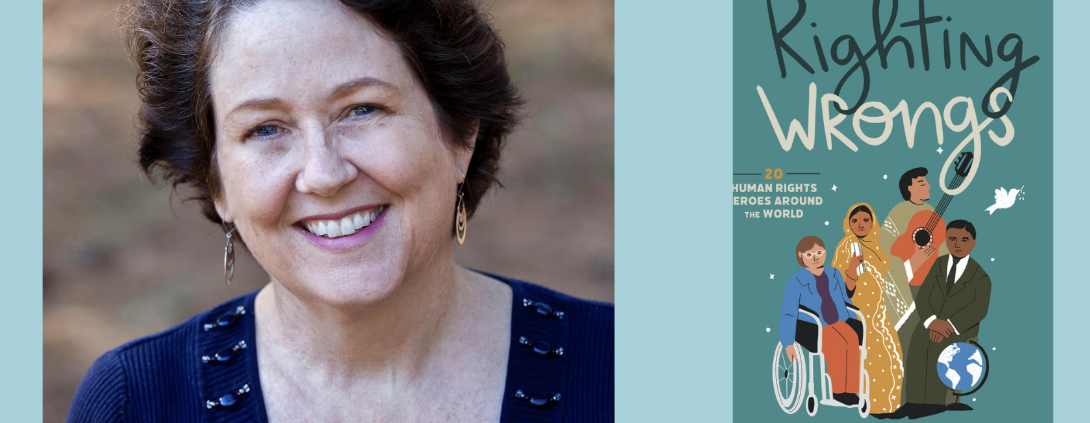Interview with Alum Robin Kirk on Two New Releases!
There seem to be two schools of thought on what to read during Unprecedented Times: fantasy to indirectly inform as one escapes reality, and nonfiction, to prepare, learn, and inform about the world in which we live. But with her two new releases, the middle grade nonfiction Righting Wrongs 20 Human Rights Heroes Around the World and the final book in her young adult fantasy trilogy, The Mother’s Wheel, Winter 2014 alum Robin Kirk has readers of both schools covered.
In addition to being a children’s book author, Kirk is also on the faculty at Duke University, where she serves as Professor of the Practice of Cultural Anthropology, Faculty Co-Chair of the Duke Human Rights Center at the Franklin Humanities Institute and a founding member of the Pauli Murray Project. Her lived and academic experience in this field has served to deepen and inform her writing, helping it to ring true in increasingly unpredictable times.
You have two very different books to discuss today! Righting Wrongs: 20 Human Rights Heroes Around the World and The Mother’s Wheel, Book Three in your YA fantasy, The Bond Trilogy. What can you tell us about each of these books?
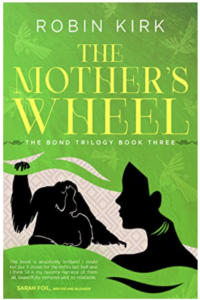 In my life, I’ve written in virtually every format: essays, op-eds, poems, fiction (novels, novellas, short stories, and flash fiction), press releases, technical reports, etc. I even drafted an opera based on my neighborhood list serve! For me, format is a choice that leads to the audience you are seeking as a writer and what effect you hope to have. But in all of these formats, my theme is very much the same: justice. In Righting Wrongs, I wanted to highlight that rights are envisioned, then won, then defended. Human rights were always something people had to think up, then work to achieve. I want kids to know about the people who did that on women’s rights, the laws of war, animal rights, and much more. In The Bond Trilogy, I use story to explore how rights work in an alternate world. My heroine, Dinitra, is raised to believe that men are inherently violent and should be eliminated. That’s one of the real-world ways of thinking that leads to genocide. In the course of the series, Dinitra comes to question everything, even the idea that animals and mutants—mixtures of animal and plant—don’t have rights equal to hers. The main character in The Mother’s Wheel is a mutant, Sil, who ends up saving her and creating a found family that is just as loving and intertwined as any purely human one.
In my life, I’ve written in virtually every format: essays, op-eds, poems, fiction (novels, novellas, short stories, and flash fiction), press releases, technical reports, etc. I even drafted an opera based on my neighborhood list serve! For me, format is a choice that leads to the audience you are seeking as a writer and what effect you hope to have. But in all of these formats, my theme is very much the same: justice. In Righting Wrongs, I wanted to highlight that rights are envisioned, then won, then defended. Human rights were always something people had to think up, then work to achieve. I want kids to know about the people who did that on women’s rights, the laws of war, animal rights, and much more. In The Bond Trilogy, I use story to explore how rights work in an alternate world. My heroine, Dinitra, is raised to believe that men are inherently violent and should be eliminated. That’s one of the real-world ways of thinking that leads to genocide. In the course of the series, Dinitra comes to question everything, even the idea that animals and mutants—mixtures of animal and plant—don’t have rights equal to hers. The main character in The Mother’s Wheel is a mutant, Sil, who ends up saving her and creating a found family that is just as loving and intertwined as any purely human one.
You’re one of the rare authors who writes fiction and nonfiction, and who writes for multiple age groups. What were the different challenges you faced writing these two books?
I think writing both is actually more common than people realize. One of the great examples of this is Margaret Atwood, who is so talented in so many genres (including picture books, a format I admire and very much hope to ad to my list). I think one challenge is to ensure that nonfiction is as gripping as fiction. People and especially kids learn through story. In Righting Wrongs, I was challenged to make sure that the sometimes messy lives I was working with had a coherence and theme that kid readers would find interesting. At the same time, I wanted to reflect that these heroes also went through times of doubt and uncertainty, as do we all.
Fantasy can be such a great tool for self-discovery. Where did the inspiration for The Bond Trilogy come from? What did you learn while writing it?
 I had just finished the draft of an adult novel and was pretty sad. I was on vacation with my family and ended up walking down a mountain largely by myself (everyone was ahead of me). I’d just finished The Book Thief by Markus Zusak and was so impressed by how he tackled the incredibly difficult theme of humanity in the midst of the Holocaust. Doubly impressive that he did this with kid readers in mind. I wanted to do something in the same spirit in a fantasy world. So I thought, ‘What group of people would most of us say has damaged the world the most – and who many would then believe should be controlled or even eliminated?’ The answer was easy: men. And that’s the seed of The Bond, where Dinitra has been taught that it’s not only natural to confine men. Getting rid of them entirely is the best and most ethical way to protect the world. What I learned is EVERYTHING. This early draft was what I sent as part of my application to VCFA. Looking back, it was TERRIBLE from start to finish and in every way. But it became the template that helped make me a better writer, good enough, at least, to turn this idea into a publishable book.
I had just finished the draft of an adult novel and was pretty sad. I was on vacation with my family and ended up walking down a mountain largely by myself (everyone was ahead of me). I’d just finished The Book Thief by Markus Zusak and was so impressed by how he tackled the incredibly difficult theme of humanity in the midst of the Holocaust. Doubly impressive that he did this with kid readers in mind. I wanted to do something in the same spirit in a fantasy world. So I thought, ‘What group of people would most of us say has damaged the world the most – and who many would then believe should be controlled or even eliminated?’ The answer was easy: men. And that’s the seed of The Bond, where Dinitra has been taught that it’s not only natural to confine men. Getting rid of them entirely is the best and most ethical way to protect the world. What I learned is EVERYTHING. This early draft was what I sent as part of my application to VCFA. Looking back, it was TERRIBLE from start to finish and in every way. But it became the template that helped make me a better writer, good enough, at least, to turn this idea into a publishable book.
Righting Wrongs is such an important book for these increasingly unprecedented times. Did anything from your personal or work experience motivate you to write it?
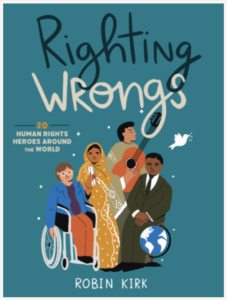 The idea was very much born in the classroom. I teach human rights to undergraduates. Again and again, I understood that they thought of human rights as something everyone got, kind of like a driver’s license, and that was consistent through time. This is in part a huge failure of the US educational system, but it goes further than that. My students simply couldn’t see that real people were behind the rights they took for granted. And real people are also constantly pushing at the boundaries of ideas of rights to include more people—women, children, LGBTQIA+, the disabled, even animals. I wrote this book not only to highlight the very real people behind human rights, but also show them, these new generations, that human rights now belongs to them and they get to continue to expand these ideas.
The idea was very much born in the classroom. I teach human rights to undergraduates. Again and again, I understood that they thought of human rights as something everyone got, kind of like a driver’s license, and that was consistent through time. This is in part a huge failure of the US educational system, but it goes further than that. My students simply couldn’t see that real people were behind the rights they took for granted. And real people are also constantly pushing at the boundaries of ideas of rights to include more people—women, children, LGBTQIA+, the disabled, even animals. I wrote this book not only to highlight the very real people behind human rights, but also show them, these new generations, that human rights now belongs to them and they get to continue to expand these ideas.
Tell us about your characters in The Bond Trilogy. What made you realize you HAD to tell their story?
I was inspired by Philip Pullman’s “His Dark Materials” series to shift point-of-view leads for each book. I love series that do that since the reader gets a new perspective with beach one and the author gets to explore the themes from different backgrounds. Dinitra is the main character in The Bond. I really wanted her to be that character that helps the readers walk through a reality that isn’t so far from our own in terms of how the logic of genocide works. She comes to see males as human and realizes she’s been lied to. The Hive Queen is from the perspective of the warrior she falls in love with, Fir. His struggle is different: how can you be free when all you’ve known is bondage? He wants to free his brothers but make serious mistakes and has to live with the consequences and still figure out what it means to be free. Sil is the main character in The Mother’s Wheel. In her case, she’s the only one of her kind since she was a failed genetic experiment. Can she ever have a family—or love someone and be loved back? I loved telling these stories since they all had to do with justice in different ways. They are all a piece of me, and I learned a lot about myself in writing the story.
What surprised you about writing these three books?
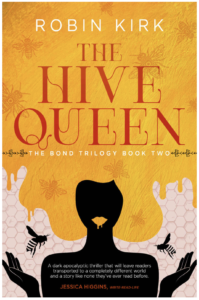 When I finished the first draft of The Bond, I thought that was it, that I was done with these characters and this world. But my son, about 10 at the time, said to me, “Boys love series. They want to know what they’re getting into. You should write a series.” I immediately dismissed this. Then gradually, I started to see how rich this world could be. The Hive Queen was terrifying to write but also so satisfying. I’d completed The Mother’s Wheel when the original published canceled the contract (in the midst of COVID). So I was faced with a choice–leave the story as is or find a way to complete the trilogy? I realized that I couldn’t leave the story behind; I needed to finish. Otherwise, I realized, this world, these beloved characters, would be no more. I HAD to finish.
When I finished the first draft of The Bond, I thought that was it, that I was done with these characters and this world. But my son, about 10 at the time, said to me, “Boys love series. They want to know what they’re getting into. You should write a series.” I immediately dismissed this. Then gradually, I started to see how rich this world could be. The Hive Queen was terrifying to write but also so satisfying. I’d completed The Mother’s Wheel when the original published canceled the contract (in the midst of COVID). So I was faced with a choice–leave the story as is or find a way to complete the trilogy? I realized that I couldn’t leave the story behind; I needed to finish. Otherwise, I realized, this world, these beloved characters, would be no more. I HAD to finish.
What are some challenges you’ve encountered in publishing a trilogy during Covid?
Having the publisher bail on the project was a real blow. But for a number of reasons, I came to see that I was much better off. I got to commission new—AND FABULOUS—covers that more accurately reflect the books. I also redesigned the interiors, a creative task I really enjoyed.
Which of the human rights heroes’ stories in Righting Wrongs were you most excited to share with your readers and why?
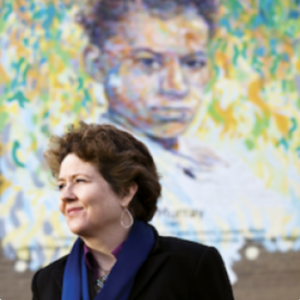 If I had to choose one, I’d say Judith Heumann, a champion of disability rights. At the time the Universal Declaration of Human Rights was agreed to in 1948, there was no recognition at all of the rights of the disabled. This is despite the fact that the person who chaired the effort, Eleanor Roosevelt, had lived with a disabled person, her husband, President Franklin D. Roosevelt (he died on an unrelated cause in 1945). Like FDR, Heumann contracted polio. She began to use a wheelchair as a young girl. At seemingly every turn, she was faced with discrimination. Instead of giving up, she and other disabled activists fought back, often very creatively. It’s largely due to their persistence that we have many accessible buildings, close-captioning, accommodations in the classroom and work, elevators, and so, so much more. Heumann is constantly reminding people that we all face potential disability because of life, especially as we age. Acknowledging and defending the rights of the disabled is good for us all.
If I had to choose one, I’d say Judith Heumann, a champion of disability rights. At the time the Universal Declaration of Human Rights was agreed to in 1948, there was no recognition at all of the rights of the disabled. This is despite the fact that the person who chaired the effort, Eleanor Roosevelt, had lived with a disabled person, her husband, President Franklin D. Roosevelt (he died on an unrelated cause in 1945). Like FDR, Heumann contracted polio. She began to use a wheelchair as a young girl. At seemingly every turn, she was faced with discrimination. Instead of giving up, she and other disabled activists fought back, often very creatively. It’s largely due to their persistence that we have many accessible buildings, close-captioning, accommodations in the classroom and work, elevators, and so, so much more. Heumann is constantly reminding people that we all face potential disability because of life, especially as we age. Acknowledging and defending the rights of the disabled is good for us all.
How do you see your body of work evolving in the future? More fantasy? More nonfiction? Or maybe branching out into other genres and age groups?
I am so excited about the future! I have a number of projects lined up: more stories in the world of The Bond Trilogy, a space opera, picture books, even a middle-grade novel. And I hope there will be a second volume of Righting Wrongs. There are so many heroes to write about!
What advice can you give new VCFA students and recent alums for keeping the joy in your writing life despite uncertainty?
Find a way to be at peace with the uncertainty.
You can learn more about Robin and her books at her website, www.robinkirk.com

